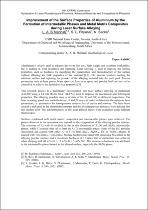 ResearchSpace
ResearchSpace
Improvement of the surface properties of aluminium by the formation of intermetallic phases and metal matrix composites during laser surface alloying
JavaScript is disabled for your browser. Some features of this site may not work without it.
- ResearchSpace
- →
- Research Publications/Outputs
- →
- Conference Publications
- →
- View Item
| dc.contributor.author |
Mabhali, Luyolo AB

|
|
| dc.contributor.author |
Pityana, Sisa L

|
|
| dc.contributor.author |
Sacks, N

|
|
| dc.date.accessioned | 2012-03-01T10:03:51Z | |
| dc.date.available | 2012-03-01T10:03:51Z | |
| dc.date.issued | 2011-05 | |
| dc.identifier.citation | Mabhali, L.A.B., Pityana, S.L. and Sacks, N. Improvement of the surface properties of aluminium by the formation of intermetallic phases and metal matrix composites during laser surface alloying. 11th International Conference on Frontiers of Polymers and Advanced Materials (ICFPAM), Conference Symposium 6: Laser Processing and Photonics: Advanced Materials and Composites for Photonics, University of Pretoria, 22-27 May 2011 | en_US |
| dc.identifier.uri | http://web.up.ac.za/sitefiles/file/44/1026/2063/13080/Symposium%206.PDF | |
| dc.identifier.uri | http://hdl.handle.net/10204/5618 | |
| dc.description | 11th International Conference on Frontiers of Polymers and Advanced Materials (ICFPAM), Conference Symposium 6: Laser Processing and Photonics: Advanced Materials and Composites for Photonics, University of Pretoria, 22-27 May 2011 | en_US |
| dc.description.abstract | Aluminium is widely used in industry due to its low cost, light weight and excellent workability, but is lacking in wear resistance and hardness. Laser alloying is used to improve the surface properties, such as hardness, by modifying the composition and microstructure of the surface without affecting the bulk properties of the material. The process involves melting the substrate surface and injecting the powder of the alloying material into the melt pool. Process parameters such as laser power, beam spot size, laser scan speed and powder feed rate have to be controlled to achieve the desired surface properties. This research project is a preliminary investigation into laser surface alloying of aluminium AA1200 using a 4.4 kW Rofin Sinar Nd:YAG laser to improve its mechanical and tribological properties. The alloying powders were a mixture of Ni, Ti and SiC in different proportions. The laser scanning speed was varied between 10 and 20 mm/s in order to determine the optimum laser parameters, i.e. parameters for homogeneous surfaces free of cracks and porosity. The laser beam created a melt pool in the aluminium substrate and the alloying powder mixtures were injected into this molten pool. The microstructures of the laser-alloyed layers were examined using different microscopes. | en_US |
| dc.language.iso | en | en_US |
| dc.relation.ispartofseries | Workflow;8290 | |
| dc.subject | Laser surface alloying | en_US |
| dc.subject | Aluminium | en_US |
| dc.subject | Metal matrix composites | en_US |
| dc.subject | Aluminium AA1200 | en_US |
| dc.title | Improvement of the surface properties of aluminium by the formation of intermetallic phases and metal matrix composites during laser surface alloying | en_US |
| dc.type | Conference Presentation | en_US |
| dc.identifier.apacitation | Mabhali, L. A., Pityana, S. L., & Sacks, N. (2011). Improvement of the surface properties of aluminium by the formation of intermetallic phases and metal matrix composites during laser surface alloying. http://hdl.handle.net/10204/5618 | en_ZA |
| dc.identifier.chicagocitation | Mabhali, Luyolo AB, Sisa L Pityana, and N Sacks. "Improvement of the surface properties of aluminium by the formation of intermetallic phases and metal matrix composites during laser surface alloying." (2011): http://hdl.handle.net/10204/5618 | en_ZA |
| dc.identifier.vancouvercitation | Mabhali LA, Pityana SL, Sacks N, Improvement of the surface properties of aluminium by the formation of intermetallic phases and metal matrix composites during laser surface alloying; 2011. http://hdl.handle.net/10204/5618 . | en_ZA |
| dc.identifier.ris | TY - Conference Presentation AU - Mabhali, Luyolo AB AU - Pityana, Sisa L AU - Sacks, N AB - Aluminium is widely used in industry due to its low cost, light weight and excellent workability, but is lacking in wear resistance and hardness. Laser alloying is used to improve the surface properties, such as hardness, by modifying the composition and microstructure of the surface without affecting the bulk properties of the material. The process involves melting the substrate surface and injecting the powder of the alloying material into the melt pool. Process parameters such as laser power, beam spot size, laser scan speed and powder feed rate have to be controlled to achieve the desired surface properties. This research project is a preliminary investigation into laser surface alloying of aluminium AA1200 using a 4.4 kW Rofin Sinar Nd:YAG laser to improve its mechanical and tribological properties. The alloying powders were a mixture of Ni, Ti and SiC in different proportions. The laser scanning speed was varied between 10 and 20 mm/s in order to determine the optimum laser parameters, i.e. parameters for homogeneous surfaces free of cracks and porosity. The laser beam created a melt pool in the aluminium substrate and the alloying powder mixtures were injected into this molten pool. The microstructures of the laser-alloyed layers were examined using different microscopes. DA - 2011-05 DB - ResearchSpace DP - CSIR KW - Laser surface alloying KW - Aluminium KW - Metal matrix composites KW - Aluminium AA1200 LK - https://researchspace.csir.co.za PY - 2011 T1 - Improvement of the surface properties of aluminium by the formation of intermetallic phases and metal matrix composites during laser surface alloying TI - Improvement of the surface properties of aluminium by the formation of intermetallic phases and metal matrix composites during laser surface alloying UR - http://hdl.handle.net/10204/5618 ER - | en_ZA |





